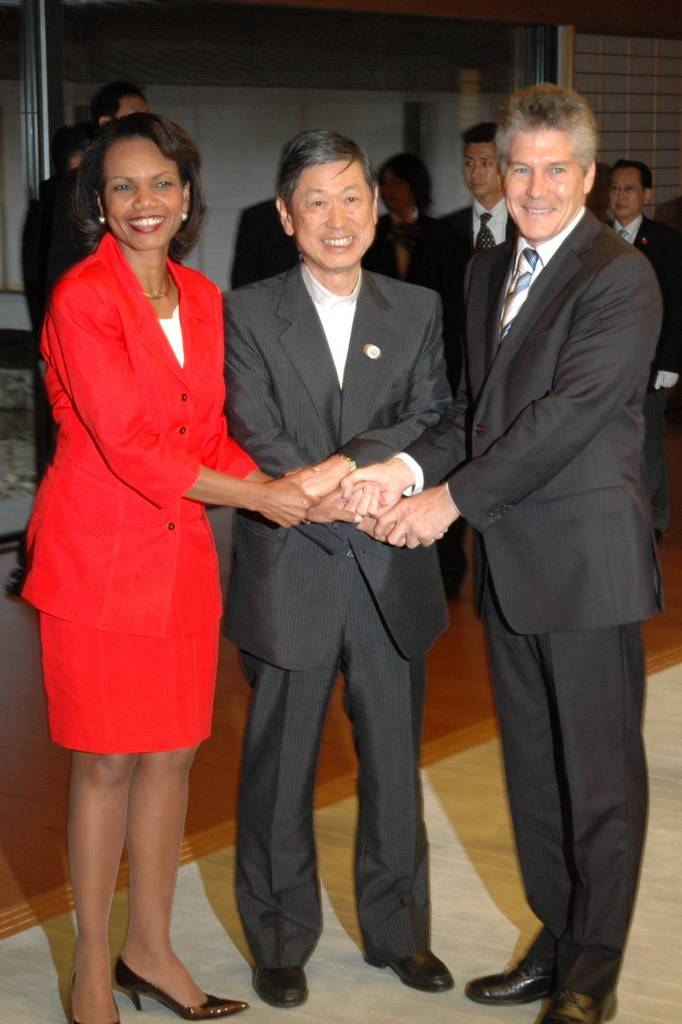This was undertaken largely at the behest of the United States, which regarded Australian-Japanese strategic relations as the ‘weak third leg’ in the regional security politics of these three Asia-Pacific maritime powers.
In March 2007, Prime Minister John Howard and his Japanese counterpart, Shinzo Abe, signed a Joint Declaration on Security Cooperation signaling stronger bilateral collaboration in intelligence-sharing, force interoperability and joint planning for a variety of transnational security contingencies. In December 2008, the second Australia-Japan Joint Foreign and Defence Ministerial Consultations reaffirmed an ‘Action Plan’ that had been announced the previous year to upgrade intelligence-sharing, expand joint military exercises and coordinate their policies on peace-building, nuclear non-proliferation and disaster relief.
These measures were strengthened at the same time as both Australia and Japan were moving to coordinate closer security ties with the United States as ‘more equal’ allies rather than as mere ‘spokes’ taking orders from an American ‘hub’.
The Australia-Japan-United States Trilateral Strategic Dialogue (TSD) was announced in 2005 as a means for channeling their growing role as independent regional and international security players into a more cohesive policy mechanism. This mechanism sought to facilitate Australia’s and Japan’s dialogue and policy planning with their American ally. After some initial glitches, the TSD affiliates have been largely successful in assuaging China’s concerns that this ‘minilateral’ grouping was directed against its
The core rationales underlying the Dialogue’s founding were to:
(1) act as a catalyst for gradually integrating the traditional bilateral security politics of containment into more cooperative multilateral security diplomacy;
(2) build on successful episodes of non-traditional security politics (e.g. peace-building and disaster relief) to coordinate future responses to emerging non-military threats;
(3) encourage Japan to pursue its own national security agendas as a moderate and self-confident regional power; and
(4) coordinate allied policy input and, where appropriate, political support for U.S. global security initiatives.
By the time Condoleezza Rice flew to Sydney to meet with former Australian Foreign Minister Alexander Downer and former Japanese Foreign Minister Taro Aso for the March 2006 inaugural TSD, systematic dialogues in these areas of development had already been under way for several years at the vice-ministerial level.
The Dialogue’s conception and development represented a unique approach to alliance politics in Asia and warranted in-depth analysis.
The March 2006 Sydney meeting represented a critical evolutionary benchmark in this grouping’s development, at a time when the nature and influence of U.S. power in the Asia-Pacific was becoming more uncertain. Greater input from analysts of the three TSD countries and from China seemed to be timely and appropriate. The chapters constituting the Special Report published by the National Bureau of Asian Research (NBR) and linked here represent the basic findings of a workshop convened by the ANU in late March 2008 to assess the TSD initiative within the broader framework of the rapidly changing Asia-Pacific security environment.
It is too soon for us to know how the Obama Administration will apply TSD politics in its own policy approaches to Asia-Pacific security. This is particularly the case, given the new Administration’s understandable preoccupation with the Global Financial Crisis (GFC). Nor is the current uncertainty underscoring Japan’s domestic political scene likely to dissipate over the near future. Along with Australia, Japan will also struggle to find daylight as the full implications of the GFC begin to be felt within the region and across the world. Organising the security order, however, remains core business in a turbulent international security environment. TSD reflects an important test case for the relevance of minilateral approaches to shaping regional security affairs.
William Tow is a Professor in the Research School of Pacific and Asian Studies, ANU. The full article, part of the NBR series, may be found here.

